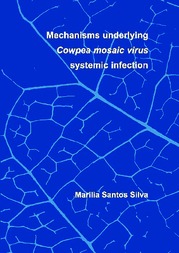Mechanisms underlying cowpea mosaic virus systemic infection.
Mechanisms underlying cowpea mosaic virus systemic infection.
Autoria: SILVA, M. S.
Resumo: Systemic virus infection of plants involves intracellular replication, local spread within the inoculated leaf (cell-to-cell movement), and subsequently, long-distance spread to other plant parts via the vasculature (vascular movement). Cell-to-cell movement occurs through the plasmodesma (PD), which are regulated channels in the cell wall connecting adjacent cells. The PD is modified by plant viral movement proteins (MP) to allow passage of a viral RNA-MP complex as happens with Tobacco mosaic virus (TMV), or virions as happens with Cowpea mosaic virus (CPMV). With the latter virus, virions move through tubules built-up from the MP (tubule-guided cell-to-cell movement). For vascular movement, viruses must enter (loading), translocate through, and exit (unloading) from the phloem. Phloem (un)loading occurs through specialized PD, named the pore-plasmodesma-unit (PPU), connecting the companion cell (CC) and sieve element (SE). The PPU allows passage ofmuch larger molecules than mesophyll PD do. Because of the peculiarities inherent to phloem tissue ( e.g. PPU), mechanisms of cell-to-cell movement are usually distinct from those ofvascular movement (reviewed in Chapter 1) for the same virus. For instance, TMV requires the viral coat protein (CP) for transport ofvirions through PPU, but the CP is dispensable for cell-to-cell movement. The success of plant virus infection is also the consequence of an antagonistic balance between viral infection and plant host defence mechanisms that specifically target viral replication ( e.g. RNA silencing), or movement ( e.g. systemic acquired resistance ). In this research thesis CPMV was used as a model for investigations on the mechanisms of systemic infection of plants. Since CPMV replication and cell-to-cell movement are well-investigated, the thesis research was concentrated on vascular movement of CPMV and on barriers imposed by different plant species against systemic infection by this virus. To examine the characteristics of vascular movement in Vigna unguiculata (cowpea), GFP-expressing CPMV (CPMV-GFP) was mechanically inoculated to primary leaves and infection was followed over time (Chapter 2). CPMV-GFP was loaded into both major and minor veins ofthe primary leaves and unloaded exclusively from major veins, preferentially class IIl, in the secondary leaves similar to the route of photo-assimilates via phloem. Using electron microscopy, virus infection was observed in all vascular cell types of the loading and unloading sites, with the exception of CC and SE. Furthermore, tubules transporting virions were never found in the PD connecting phloem parenchyma ce1ls (PPC) and CC, or CC and SE (i.e. PPU)...
Ano de publicação: 2004
Tipo de publicação: Teses
Unidade: Embrapa Cerrados
Palavras-chave: Cowpea mosaic virus, Feijão de Corda, Mosaico, Planta, Resistência Genética, Variedade Resistente
Observações
1 - Por padrão são exibidas publicações dos últimos 20 anos. Para encontrar publicações mais antigas, configure o filtro ano de publicação, colocando o ano a partir do qual você deseja encontrar publicações. O filtro está na coluna da esquerda na busca acima.
2 - Para ler algumas publicações da Embrapa (apenas as que estão em formato ePub), é necessário ter, no celular ou computador, um desses softwares gratuitos. Sistemas Android: Google Play Livros; IOS: iBooks; Windows e Linux: software Calibre.
Acesse outras publicações
Acesse a Base de Dados da Pesquisa Agropecuária (BDPA) para consultar o acervo completo das bibliotecas da Embrapa.

